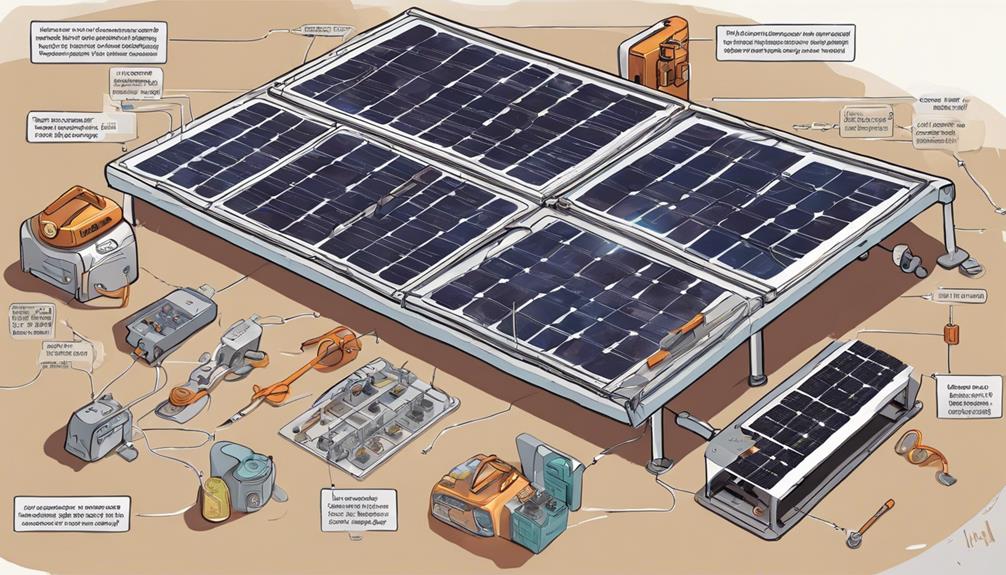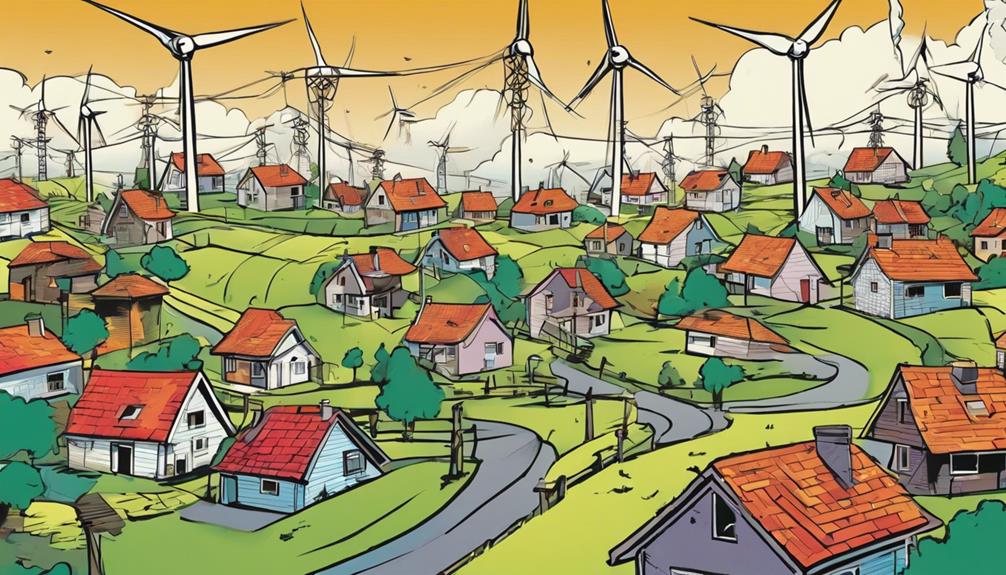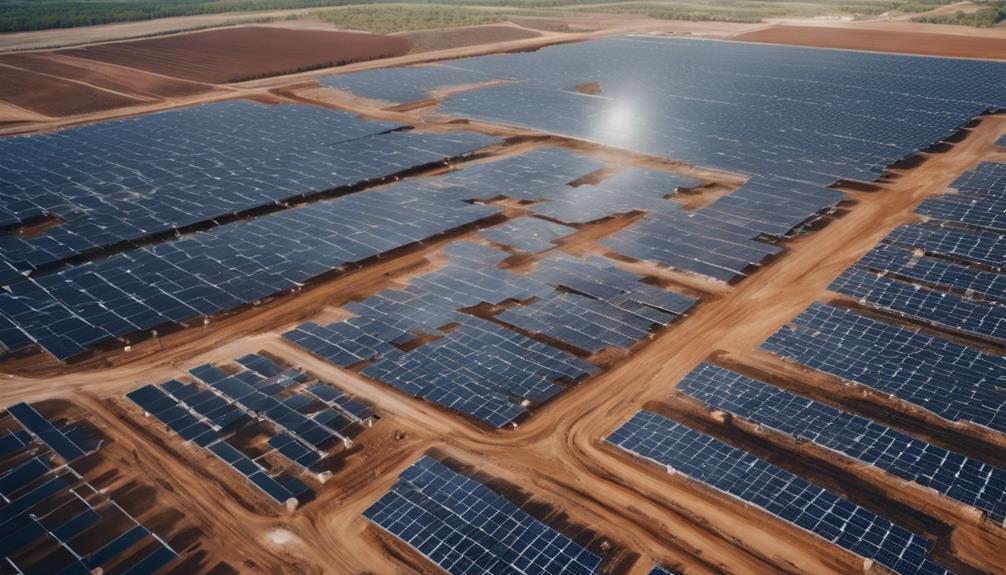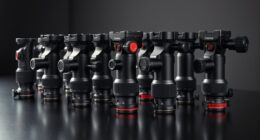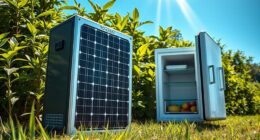Solar panels are made up of monocrystalline or polycrystalline cells to convert sunlight into electricity. These cells have high efficiency ratings for best energy production. Inverters play a vital role by converting DC electricity to AC. They come in string or micro configurations depending on your needs. The electrical panel manages power distribution effectively. Excess energy can be stored for later use, enhancing reliability during outages. Learning about solar panel components and functions is essential to harnessing sustainable energy sources efficiently.
Key Takeaways
- Solar panels convert sunlight into electricity using photovoltaic cells.
- Inverters transform DC power from panels into usable AC electricity.
- Electrical panels distribute solar electricity throughout the home.
- Excess energy can be stored in batteries for later use.
- Energy storage systems enhance reliability and reduce grid dependence.
Solar Panel Types
When discussing solar panels, there are primarily three types to explore: monocrystalline, polycrystalline, and amorphous silicon cells. Monocrystalline panels are well-known for their high efficiency and exceptional quality. They're crafted from single silicon blocks, which contribute to their superior performance.
On the other hand, polycrystalline panels are a more cost-effective choice. These panels are produced by melting multiple silicon crystals together, making them a favored option for those on a budget.
Furthermore, there are amorphous silicon cells that offer versatility in design and application. While monocrystalline panels have a more labor-intensive production process, they compensate for it with their excellent efficiency.
When choosing among these types, factors such as budget, space availability, and efficiency requirements play a significant role in determining the best fit for your solar panel needs.
Solar Panel Efficiency
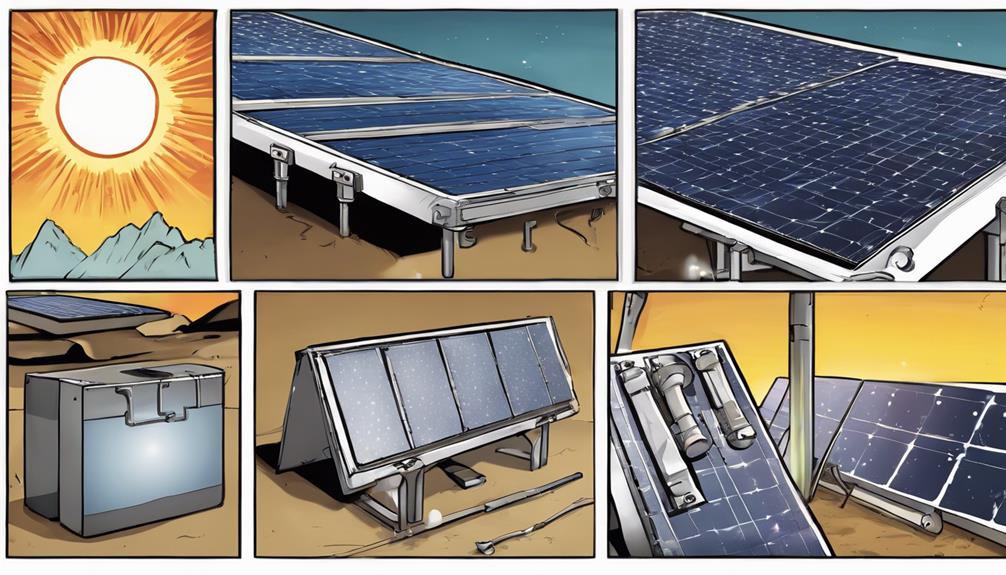
Solar panel efficiency directly impacts the amount of electricity generated per square foot. Efficiency rating, which indicates the percentage of sunlight converted into electricity, plays a critical role in maximizing energy production.
Monocrystalline panels are known for their higher efficiency, reaching up to 22%, compared to polycrystalline panels. Premium panels are especially efficient, with some models achieving this high percentage of efficiency.
Factors like temperature, shading, and orientation towards the sun can influence solar panel efficiency. High temperatures can decrease efficiency, while shading from trees or buildings can have a similar effect. Ensuring that panels are properly oriented towards the sun throughout the day can help maximize energy production.
Improving solar panel efficiency is vital not only for generating more electricity but also for reducing overall system costs in the long run.
Inverter Functionality

Inverters efficiently convert DC electricity from solar panels into AC electricity for household consumption. String inverters gather electricity from multiple panels connected in a string configuration, while microinverters, installed on individual solar panels, work to optimize energy production.
Both types of inverters are essential in ensuring a smooth progression of solar power to power household appliances. String inverters are cost-effective and suitable for installations where panels receive uniform sunlight. On the other hand, microinverters offer advantages such as panel-level monitoring and increased flexibility in system design.
Power Distribution
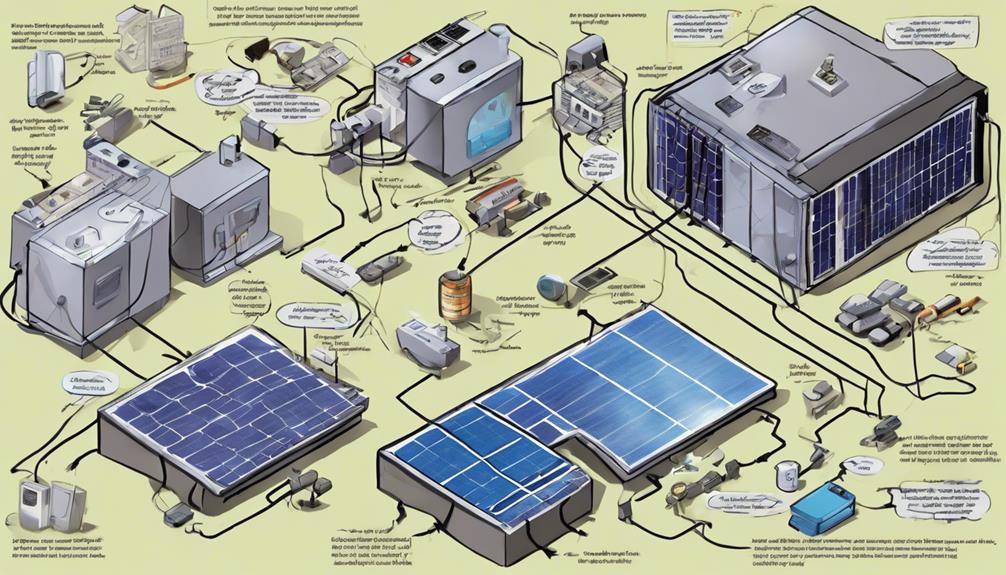
To efficiently power your household appliances with solar energy, the connection of solar panels to the home's electrical panel is vital for distributing electricity effectively.
The electrical panel serves as the gateway for solar energy distribution, ensuring that important appliances such as refrigerators and air conditioning systems are powered efficiently.
In cases where there's excess solar energy generated, it can be sent back to the grid, either for credits or to benefit other users in the network.
An electric meter plays a pivotal role in this process by measuring the flow of electricity in and out of the home, tracking solar energy usage and grid interactions accurately.
Managing grid interaction is crucial for handling energy fluctuations and optimizing the use of solar power in residential settings, ensuring a consistent and reliable source of energy for your home's needs.
Energy Storage Systems

Connecting your solar panels to an Energy Storage System (ESS) allows you to store excess electricity for later use, providing uninterrupted power during outages. ESS, often in the form of solar batteries, stores the energy generated by your solar panels, offering you the flexibility to use it whenever needed. This stored energy enhances the reliability of your power supply, ensuring a constant source of electricity even when sunlight is unavailable.
Adding an ESS to your solar system is an optional feature that can greatly enhance your energy independence. By storing surplus energy during times of low demand, you can optimize your energy usage by utilizing this stored energy during peak demand or when your solar panels aren't actively generating electricity.
This feature not only provides you with backup power but also helps reduce your reliance on the grid, making your energy consumption more sustainable and cost-effective.
Solar Panel Composition

The composition of solar panels comprises silicon solar cells, a metal frame, a glass sheet, standard wire, and bus wire. Silicon solar cells play a pivotal role in the conversion of sunlight into electricity within the solar panel. The metal frame not only provides protection against various weather elements but also ensures the secure mounting of the solar panel. The glass sheet, typically around 6-7 millimeters thick, acts as a shield safeguarding the solar cells from any potential damage. Additionally, both bus wire and standard wire are essential components that facilitate the efficient transfer of the generated electricity from the solar panel.
| Component | Function |
|---|---|
| Silicon Solar Cells | Convert sunlight into electricity within the panel |
| Metal Frame | Provides protection and aids in secure mounting |
| Glass Sheet | Shields and safeguards solar cells from damage |
| Bus Wire & Standard Wire | Enable efficient electricity transfer |
Manufacturing Process
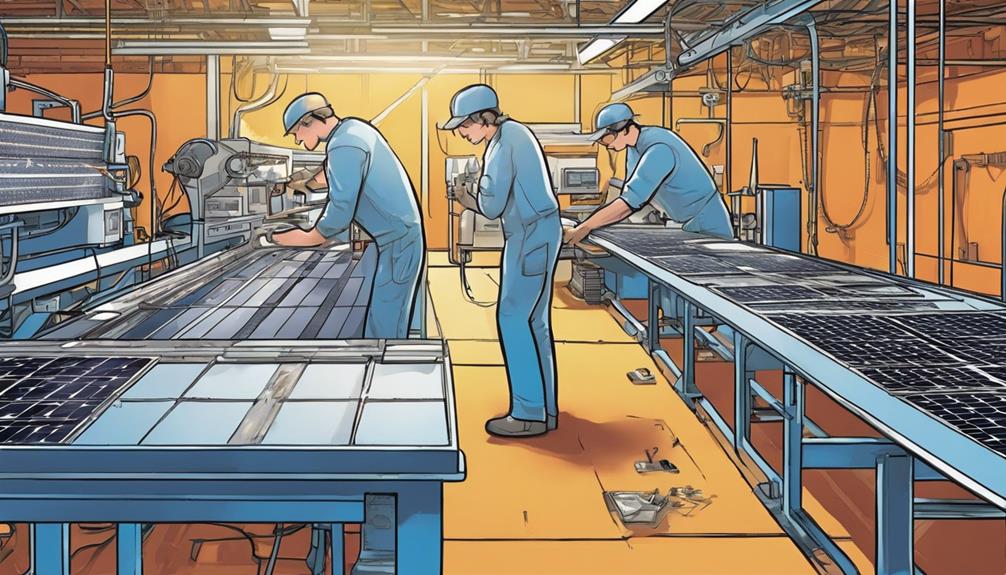
Crafting solar panels involves a meticulous manufacturing process that integrates various components to harness sunlight efficiently and convert it into electricity. This process includes building solar cells, soldering them together, and sealing them under anti-reflective glass.
Critical steps involve installing the backsheet, glass layer, frame, and junction box, followed by rigorous quality testing. Different types of solar cells, such as N-type and P-type, vary in chemistry and efficiency, impacting the overall performance of the panel.
The key components of solar panels typically consist of silicon solar cells, a metal frame, a glass sheet, standard wire, and bus wire. By carefully assembling these elements, solar panels can effectively capture sunlight and transform it into usable electrical power, making them a sustainable and eco-friendly energy solution for various applications.
Frequently Asked Questions
What Are the Key Components of a Solar System?
You've got solar panels, inverters, electrical panels, electric meters, and the sun as key components in a solar system. Panels absorb sunlight, inverters switch DC to AC, electrical panels distribute power, and meters track usage.
What Are the Main Components in Solar Panels?
When you gaze at solar panels, remember they're like a well-oiled machine. Silicon solar cells, metal frame, glass sheet, standard wire, and bus wire work harmoniously to transform sunlight into electricity efficiently.
How Solar Panels Work Step by Step?
To understand how solar panels work step by step, sunlight is absorbed by silicon cells to create DC electricity. The inverter then converts this into AC electricity for your home. Solar energy powers devices and can even reduce energy bills.
What Is the General Structure of a Solar Panel and How Does It Work?
To understand the general structure and function of a solar panel, note that it comprises silicon cells, a metal frame, glass sheet, wires. These components work together: cells absorb sunlight, generating electricity for conversion.
What Key Components of Solar Panels Make Them Different from Solar Cells?
Solar panels and cells have a key difference. Solar panels are made up of multiple solar cells, while individual solar cells are the building blocks of solar panels. The panels are designed to capture, convert, and store sunlight, while cells are responsible for generating electricity from sunlight. Understanding the difference between solar panels and cells is crucial for harnessing solar energy efficiently.
How Do the Key Components of Solar Panels Contribute to Promoting Sustainability and Environmental Responsibility?
The key components of solar panels, such as photovoltaic cells and the inverter, play a crucial role in promoting sustainability through solar panels. By harnessing solar energy and converting it into electricity, these components contribute to reducing reliance on non-renewable energy sources, thereby advancing environmental responsibility.
Conclusion
Now that you've learned about the key components of solar panels and how they work, you're ready to harness the power of the sun like a pro.
With efficiency, inverters, power distribution, and energy storage on your side, you're equipped to generate clean, renewable energy.
Keep shining bright like a solar panel and let the sun do its magic!
